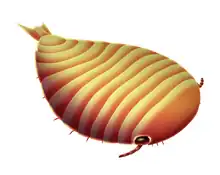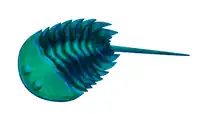| Sidneyia Temporal range: | |
|---|---|
 | |
| Reconstruction of Sidneyia minor | |
 | |
| Fossil of S. inexpectans | |
| Scientific classification | |
| Domain: | Eukaryota |
| Kingdom: | Animalia |
| Phylum: | Arthropoda |
| (unranked): | †Artiopoda |
| (unranked): | †Vicissicaudata |
| Genus: | †Sidneyia Walcott, 1911 |
| Type species | |
| †Sidneyia inexpectans Walcott, 1911 | |
| Species | |
| |
Sidneyia is an extinct arthropod known from fossils found from the Early to the Mid Cambrian of China and the Mid Cambrian Burgess Shale of British Columbia, Canada.
Description


Sidneyia inexpectans reached lengths of at least 160 millimetres (6.3 in).[1] The largest known specimen of S. minor is around 23 mm (0.91 in) long and 14 mm (0.55 in) wide,[2] while the largest specimen of S. malongensis is 31 mm (1.2 in) long and 21 mm (0.83 in) wide.[3] The head shield is short, with notches present on the sides to accommodate stalked eyes, with the underside having a hypostome. The head has a pair of segmented antennae, as well as three pairs of post-antenal appendages. This was followed by a thorax, which had eight to ten segments/tergites, each associated with a pair of biramous appendages, this was followed with one to three abdomen segments/tergites, with the body terminating with a telson, which comprised a pair of tail flukes.[2][3] The appendages bear heavily sclerotised spined basal segments (basipods) called gnathobases, used to process food.[2][1][4] In S. minor, the biramous appendages have 8 podomeres/segments on the endopod, with the last segment being a terminal claw. The exopod of these limbs is flattened and bears lamellae.[2] In S. inexpectans, the endopods of the biramous limbs have seven podomeres, with the first four of these each bearing a number of thin inward projecting spines, while the outer three podomeres bore more stout claw-like spines, with the fourth to ninth pairs of post antennal limbs bearing exopods with blade-like lamellae, which are thought to have been used as gills.[1] S. inexpectans had three pairs of digestive glands within the head shield and front of the thorax, adjacent to the central gut tube.[1]
Ecology
Sidneyia is thought to have been seafloor dwelling (epibenthic) generalist durophagous predator and/or scavenger that used its gnathobases (which closely resemble those of horseshoe crabs) to crush and shred prey items, including hard-shelled organisms like juvenile trilobites (which are abundantly preserved as stomach contents in S. inexpectans) and brachiopods (representing around 6% of the stomach contents of S. inexpectans), but possibly also softer animals like worms or soft bodied arthropods like bradoriids.[1][5]
Taxonomy
Sidneyia was discovered in 1910 during the first day of Charles Walcott's exploration of the Burgess Shale. He named it after his elder son, Sidney, who had helped to locate the site and collect the specimen. The species name, Sidneyia inexpectans, is derived from the meaning of "Sidney's surprise".[6]
144 specimens of Sidneyia are known from the Greater Phyllopod bed, where they comprise 0.27% of the community.[7]
Sidneyia sinica was named in 2002 from a specimen found in the Chengjiang Biota of South China.[8] However, it has since been rejected from the genus, and other indeterminate specimens assigned to the genus from the Spence Shale and Sirius Passet lack key diagnostic characters. Specimens that can confidently assigned to the genus include Sidneyia cf. inexpectans, known from the Wuliuan Mantou Formation of North China,[9] Sidneyia minor from the Early Cambrian (Cambrian Stage 3) Xiaoshiba Biota of Yunnan, China,[2] and a valid species of Sidneyia from Chengjiang, Sidneyia malongensis.[3]
In 1923, Sidneyia, was placed, along with Emeraldella, as part of the group "Xenopoda". Today, both Sidneyia and Emeraldella are placed as part of the clade Vicissicaudata within Artiopoda, which includes trilobites and other arthropods with similar bodyforms. However, Sidneyia and Emeraldella are usually not recovered as each others closest relatives within Vicissicaudata, rendering "Xenopoda" invalid.[10]
See also
References
- 1 2 3 4 5 Zacaï, Axelle; Vannier, Jean; Lerosey-Aubril, Rudy (2016). "Reconstructing the diet of a 505-million-year-old arthropod: Sidneyia inexpectans from the Burgess Shale fauna". Arthropod Structure & Development. 45 (2): 200–220. doi:10.1016/j.asd.2015.09.003. PMID 26410799. S2CID 12638165.
- 1 2 3 4 5 Du, Kunsheng; Bruton, David L.; Yang, Jie; Zhang, Xiguang (2023-02-13). "An early Cambrian Sidneyia (Arthropoda) resolves the century-long debate of its head organization". Science China Earth Sciences. 66 (3): 521–527. Bibcode:2023ScChD..66..521D. doi:10.1007/s11430-022-1019-8. ISSN 1869-1897. S2CID 257177978.
- 1 2 3 Zhu, Y.; Zeng, H.; Liu, Y.; Zhao, F. (2023). "New artiopodan euarthropods from the Chengjiang fauna (Cambrian, Stage 3) at Malong, Yunnan, China". Acta Palaeontologica Polonica. doi:10.4202/app.01080.2023.
- ↑ Bicknell, Russell D.C; Paterson, John R; Caron, Jean-Bernard; Skovsted, Christian B (2017). "The gnathobasic spine microstructure of recent and Silurian chelicerates and the Cambrian artiopodan Sidneyia : Functional and evolutionary implications". Arthropod Structure & Development. 47 (1): 12–24. doi:10.1016/j.asd.2017.12.001. PMID 29221679. S2CID 46830374.
- ↑ Bicknell, Russell D. C.; Ledogar, Justin A.; Wroe, Stephen; Gutzler, Benjamin C.; Watson, Winsor H.; Paterson, John R. (2018-10-24). "Computational biomechanical analyses demonstrate similar shell-crushing abilities in modern and ancient arthropods". Proceedings of the Royal Society B: Biological Sciences. 285 (1889): 20181935. doi:10.1098/rspb.2018.1935. ISSN 0962-8452. PMC 6234888. PMID 30355715.
- ↑ "The arthropod Sidneyia inexpectans , Middle Cambrian, Burgess Shale, British Columbia". Philosophical Transactions of the Royal Society of London. B, Biological Sciences. 295 (1079): 619–653. 1981-12-18. Bibcode:1981RSPTB.295..619B. doi:10.1098/rstb.1981.0164. ISSN 0080-4622.
- ↑ Caron, Jean-Bernard; Jackson, Donald A. (October 2006). "Taphonomy of the Greater Phyllopod Bed community, Burgess Shale". PALAIOS. 21 (5): 451–65. Bibcode:2006Palai..21..451C. doi:10.2110/palo.2003.P05-070R. JSTOR 20173022. S2CID 53646959.
- ↑ Zhang, Xingliang; Han, Jian; Shu, Degan (27 Nov 2008). "New occurrence of the Burgess Shale arthropod Sidneyia in the Early Cambrian Chengjiang Lagerstätte (South China), and revision of the arthropod Urokodia". Alcheringa: An Australasian Journal of Palaeontology. 26: 1–8. doi:10.1080/03115510208619239. S2CID 129442308.
- ↑ Sun, Zhixin; Zeng, Han; Zhao, Fangchen (March 2020). "First occurrence of the Cambrian arthropod Sidneyia Walcott, 1911 outside of Laurentia". Geological Magazine. 157 (3): 405–410. Bibcode:2020GeoM..157..405S. doi:10.1017/S0016756819000864. ISSN 0016-7568. S2CID 202899205.
- ↑ Briggs, Derek E. G.; Siveter, David J.; Siveter, Derek J.; Sutton, Mark D.; Legg, David; Lamsdell, James C. (August 2023). "A vicissicaudatan arthropod from the Silurian Herefordshire Lagerstätte, UK". Royal Society Open Science. 10 (8): 230661. doi:10.1098/rsos.230661. ISSN 2054-5703. PMC 10394423. PMID 37538743.
External links
- "Sidneyia inexpectans". Burgess Shale Fossil Gallery. Virtual Museum of Canada. 2011. Archived from the original on 2020-11-12. Retrieved 2023-02-09.
Further reading
- D. L. Bruton (1981). "The arthropod Sidneyia inexpectans, Middle Cambrian, Burgess Shale, British Columbia". Philosophical Transactions of the Royal Society B: Biological Sciences. 295 (1079): 619–653. Bibcode:1981RSPTB.295..619B. doi:10.1098/rstb.1981.0164.



